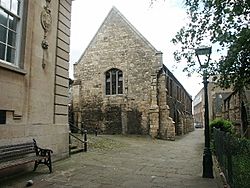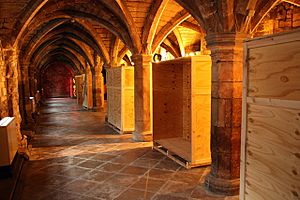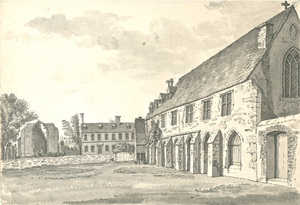Greyfriars, Lincoln facts for kids
Quick facts for kids The Greyfriars, Lincoln |
|
|---|---|

The Greyfriars, Lincoln
|
|
| Location | Lincolnshire |
| OS grid reference | SK9775971248 |
| Founded | c1230 |
| Built | 13th century, with mid-19th century additions. |
| Restored | 1906 |
| Architect | William Watkins |
| Architectural style(s) | Early English architecture |
|
Listed Building – Grade I
|
|
| Designated | 8 October 1953 |
| Reference no. | 485917 |
| Lua error in Module:Location_map at line 420: attempt to index field 'wikibase' (a nil value). | |
The Greyfriars, Lincoln is a very old building in Lincolnshire, England. It used to be part of a Franciscan friary, which was a place where a group of religious people called friars lived and worked. The part of the building that is still standing today was likely the friary's hospital or "infirmary." It was built around 1230 using stone and brick, with some parts added in the mid-1800s.
Contents
A Look Back: Greyfriars History
The Franciscan Friary
The Franciscans were a group of friars who followed the teachings of St. Francis of Assisi. They often lived simply and helped people in their communities. Building of the Greyfriars friary started in 1237. The land was given to the Franciscan order for their new home. The friary was fully built by the 1280s.
However, the friars were forced to leave in 1538. This happened during a time called the Dissolution of the Monasteries. During this period, King Henry VIII closed down many monasteries and friaries in England.
From Friars to Students: A School's Story
After the friars left, the building was rented out. In 1568, a school was opened there by Richard Monson. From 1574, this school became the official Corporation Grammar School. The Lincoln City Council ran the school on the upper floor until 1900.
The lower part of the building, called the undercroft, had many uses. First, it was a spinning school until 1831, known as the Jersey School. Then, from 1833 to 1862, it became a Mechanics' Institute. A Mechanics' Institute was a place where working people could learn about science and technology. A famous mathematician, George Boole, was involved with this institute. From 1862 to 1899, the undercroft was also used as part of the Grammar School.
Greyfriars as a Museum
In 1900, the building stopped being a school. It was then carefully fixed up by a Lincoln architect named William Watkins. On May 22, 1907, it opened to the public as the City and County Museum.
Managed by Lincoln City Council
The City of Lincoln managed the museum at first. Arthur Smith was the first person in charge, called the Curator. He retired in 1934. After him, F. T. (Tom) Baker took over. His father, Fred Baker, was also a well-known architect in Lincoln.
Managed by Lincolnshire County Council
In 1974, the Lincolnshire County Council took over running the museum. In 1993, the museum's role at Greyfriars changed. The building started to host different exhibitions each year. Meanwhile, the main collections were being prepared for a new, bigger home.
In 2005, a new museum called The Collection opened. It was built on a new site next to the Usher Gallery. These two places are now managed together as a cultural center for art and history.
After the museum moved out, the Greyfriars building was used by the Central Library for a while. Since 2008, it has mostly been empty. Sometimes, it is used for modern art shows. In 2016, the city council thought about selling the building.



